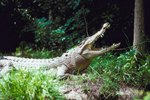
The most densely populated country in Central America, El Salvador is a small Central American nation -- about the size of Massachusetts -- that lies nestled between Honduras, Guatemala and the Pacific Ocean. Topographically, the country features a small coastal plain and central plateau, both of which have tropical climates; however, most of the country is mountainous and has a temperate climate. A number of potentially dangerous animals inhabit the country, including snakes, invertebrates, sharks and crocodiles.
Snakes
Several dangerously venomous snakes inhabit El Salvador. Coral snakes (Micrurus sp.) are dangerous, snake-eating elapids who are ringed in red, yellow and black. Cantils (Agkistrodon bilineatus), jumping vipers (Atropoides occinduus), mountain pit vipers (Cerrophidion godmani), hognosed pit vipers (Porthidium ophryomegas) and Central American rattlesnakes (Crotalus simus) are all venomous pit vipers native to the country. Several mildly venomous colubrids inhabit the country, but human cases of envenomation are rare.
Crocodilians
The American crocodile (Crocodylus acutus) lives along the coast of El Salvador and is the largest crocodilian found in the region -- occasionally exceeding 20-feet in length. Two smaller crocodilians, the spectacled caiman (Caiman crocodilus crocodilus) and the brown caiman (Caiman crocodilus fuscus) also live in El Salvador but don't reach such large sizes. All crocodilians are potentially dangerous and should be treated with respect. Most crocodilians are nocturnal -- so avoid areas near water after dark.
Mammals
Jaguars (Pantera onca) and mountain lions (Felis concolor) are the two largest and most dangerous mammals native to Central America, but both are extinct in El Salvador. Coyotes live throughout the country. In addition to scavenging, they eat a variety of small and medium-size prey. Coyotes (Canis latrans) are not regarded as dangerous to adults, but do not leave children unattended in areas with coyote activity.
Invertebrates
El Salvador is home to many venomous scorpions, centipedes and spiders, but the country is outside the range of many of the most dangerous Central American species. The infamous bullet ants (Paraponera clavata) of the rain forest -- reportedly possessing the most painful ant or wasp venom known -- do not live as far north as El Salvador. Likewise, the deadly scorpions of the genus Tityus, which can deliver lethal stings, are not native to the country. Most venomous invertebrates will not sting unless provoked; most stings can be avoided with the use of mosquito nets the practice of shaking clothing and shoes vigorously before putting them on.
Sharks and Other Marine Threats
Though sharks live along most of Central America, El Salvador has a paucity of reported shark attacks. The International Shark Attack File lists only two reports of unprovoked attacks since 1880. The most recent attack took place in 1993 and was fatal for the victim. Stingrays and jellyfish are also common in the waters around El Salvador. While they usually do not cause life-threatening injuries, they demand respect.
References
- Central Intelligence Agency: The World Factbook: El Salvador
- National Geographic: El Salvador Guide
- Vapa Guide: Distribution of Terrestrial Venomous Snakes: El Salvador
- Crocodilian.com: Species Range Maps
- Animal Diversity Web: Caiman Crocodylus
- Animal Diversity Web: Crocodylus Acutus
- Panthera: Jaguars
- Area: Public Perceptions of Jaguars Panthera Onca, Pumas Puma Concolor and Coyotes Canis Latrans in El Salvador
- The Scorpion Files Newsblog: Scorpionism in Central America - a Review
- Florida Museum of Natural History: Shark Attack File: 1880-2012 Map of Middle America's Confirmed Unprovoked Shark Attacks
Photo Credits
-
Jupiterimages/Photos.com/Getty Images



